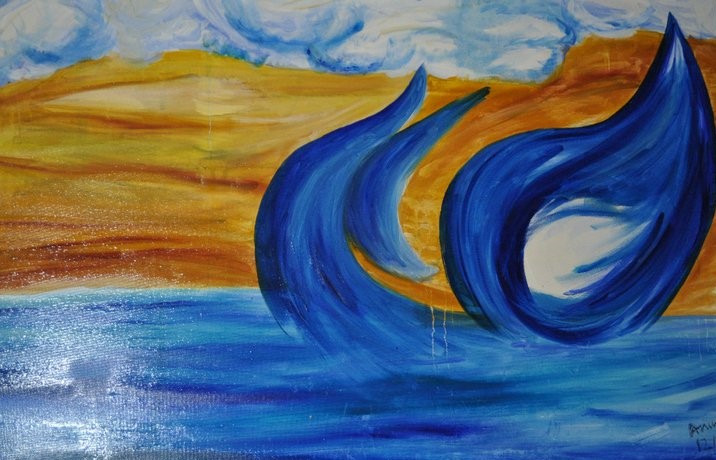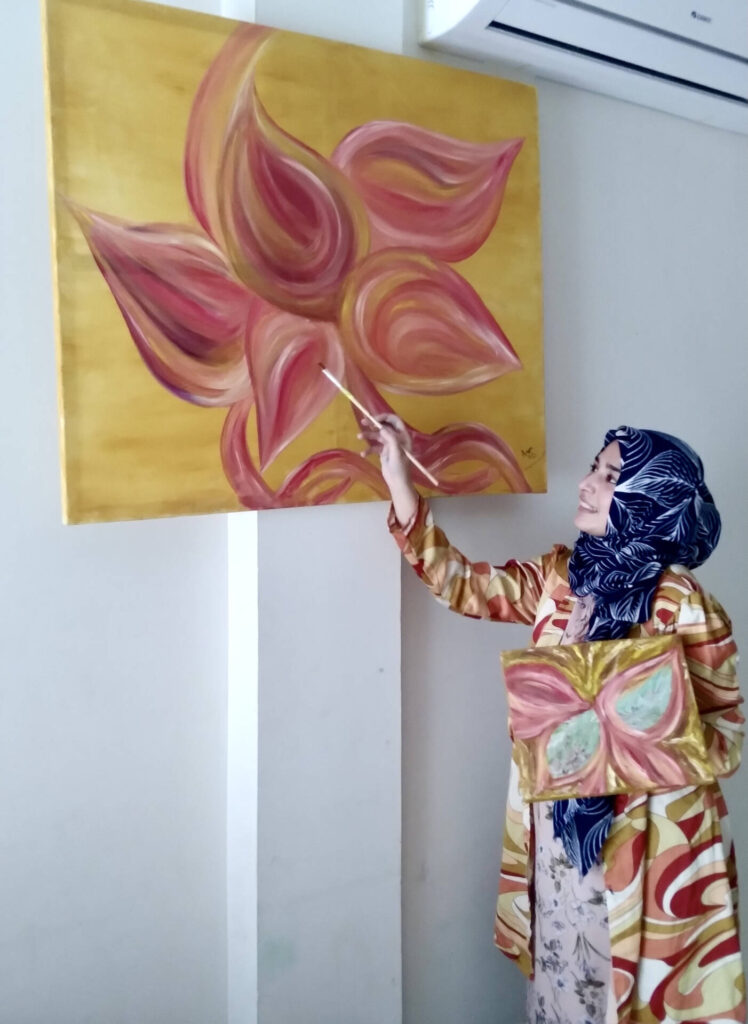The artist who explores Science via Art

Hello Anum, it’s really a pleasure to know each other – even if only virtually, for now. Thanks for sharing your world and artistic path with Art On Gallery. Can you tell our readers something about you? Where do you come from and which is your educational background?
Thank you and likewise, a great honour to have this conversation. I grew up in north London and studied at a school which was about a hundred years old. I remember walking down cobbled paths to Enfield County School, with aplenty of daffodils in the spring along the way.
I went on to study Biochemistry with Management from Imperial College London, as well as a History of Art course at University College London. Am also an Associate of the Royal College of Science through Imperial, thereafter I completed my PGCE and then obtained my QTS through the Department of Education, England.
We know you’re an Associate of the Royal College of Science in London as well as an international educator, mentor and consultant. How does your artistic practice intertwine with your everyday life?
During my professional practice as an educator and mentor, the process of observation continues, for instance it could be a focus on behaviour management and an act of kindness or teamwork observed. That would be a thoughtful stimulus to explore in my art, through the links to humanity.
Practically, my artistic practice comes to life in the evening when my children are sleeping and won’t run after my paint tubes! I have set aside an area as a mini studio, to ensure focus on the artwork. This is also an interesting point for working women artists who are also mothers, it’s a tough schedule, but with hard work and discipline, miracles can be woven into the reality of life and art!
Your interest in exploring the relationship between Science and Art is a distinctive feature which influences your production. How does this help you practically to conceptualise new works?
My interest in exploring the relationship between Science and Art stems from my background in Biochemistry, as well as utilizing pedagogical approaches in combining these disciplines via cross curricular links. I utilize the stages of observation and experimentation from the Scientific method, in my approach to Art, for instance I observe the natural world around us, whether that be the shape of a leaf, patterns in the waves and rocks, colours in the cloud formations to the shape and texture of the tree branches and so on. Then, I experiment with distilling these themes into the abstract paintings or I simply photograph the biology of life with links to human insights and emotions.
My painting “Certainty (2011)” focused on patterns in nature; of light overcoming darkness, rain from the clouds cleansing, nourishing and healing the Earth. Vulnerable saplings blooming with time, and subtle droplets of water bringing forth strong roots and natural justice. These natural themes also linked to the ‘our journey’ of life, with challenges and miracles yet certainty that destiny and truth will triumph.

In looking towards the future, to further strengthen the ties between Art and Science by exploring the themes of wind and kinetic energy in the natural world, with links to human emotions; essentially how does the sea breeze make you feel? Such explorations, I hope will also influence the academic aspect, in expanding the cross-curricular links between Art and Science for a holistic learning experience.
“Nature is king” in your artistic process. Apart from it, what do you gain artistic inspiration from?
My art has strong links with nature, faith, inner perspectives, and humanity, and is deeply connected and influenced by the natural world. In the photograph “Zephyr Nostalgia”; there is an exploration of sound and colour. One of my most favourite sounds is hearing laughter in the wind. It evokes a distant memory of running with and against the wind, as a child hands outstretched, and bursting into peals of laughter at the simple joy of it. The colours blend in a zephyr nostalgia as if the wind is pulling them as the hues intermix and are pulled towards the sounds of life.

According to you, which is the difference between painting and photography in terms of self-expression?
Ultimately, I think it depends on the artist and how they utilize the mediums.
Overall, I think painting provides a little bit more freedom in terms of self-expression and there are times where I have completed a painting over months, and it still is incomplete. Some of my paintings over a decade ago are left unfinished, and can be revisited. Furthermore, there are times when the canvas has started off with particular colours, tones and brushstrokes, only to be completely changed during the process, even with the mediums used. I might start off with acrylic or gouache and finish off with oil. I think because I am self-taught, perhaps in my ‘ignorance’ I am a little bit more uninhibited.
In photography, I feel there is less room to manoeuvre once the original is complete. Once the photograph is taken, it captures a particular moment in time, and for self-expression. It cannot be changed unless a new photograph is taken or it is altered digitally so I feel photography is perhaps a more, disciplined and rigid form of self-expression compared to painting.
In your writing and poetry a delicate attention to spirituality and humanity arises. How did this philosophical approach develop in your life as a woman and as an artist?
As a woman, starting off as a young girl whose father had died, who did not have any brothers or sisters and whose mother was schizophrenic. I faced incredible challenges in my life and even as a child, utilised art as a form of expression and healing. I started writing poetry at the age of twelve exploring my curiosities and observing the world around me. When I would face difficulties in my life, I would go to the mountains or literally climb trees in the park and look out towards the horizon, I would surround myself with nature and think that if the Creator has made such a beautiful world and maintains it so well, then I as a very small part of it would be looked after by Him, and that would calm my fears.
I also am a keen traveller, and as an artist greatly absorb lessons from all the cultures and places that I have been fortunate enough to visit. For instance, around 2014, I stayed in a farm in Greve in Chianti, and that really was a wonderful experience being immersed in nature. From there, I visited the Uffizi Gallery, which for a self taught artist like myself, was an incredible experience to see the works in real life, from the likes of Leonardo da Vinci to Michelangelo. I further explored Florence and Sienna, and gained immense insights from beautiful architecture, people, art, food and the mesmerizing culture
In my painting “Sanctuary”, I explore the concept of looking for a sanctuary to heal, to become whole, to answer our calling. In saving ourselves, we gain the courage to save others. This painting is about holistic healing; the warm, homely hues a calling to the soul towards calm and kind healing. The underlying tones of Sienna; reminiscent of a time of quiet discovery through nature and colour. In exploring the world around us, in finding a sanctuary, in looking inwards to complete ourselves…we begin the journey to heal the world around us.

Let’s focus on your interest in promoting cultural differences and human interconnections. Can you tell us something more about your participation in the “Urban Dialogues Festival Exhibition” in London?
The Urban Dialogues Festival Exhibition in London was in the Red Gallery, in conjunction with Shared Roots in Faith. It was a group exhibition and my artwork there was influenced by my interfaith work on various projects with these organizations, from conducting oral history interviews of Muslim, Jewish and Christian elders in London and transforming their stories into art for an interfaith harmony rotational exhibition in Tower Hamlets Library, a Cathedral in London as well as the Red Gallery, in an exploration of the shared heritage of the Abrahamic faiths and to understand and celebrate diverse faith and cultures.


Has the Covid-19 pandemic and its associated lockdowns changed your personal approach to art?
Yes, it has definitely. It’s allowed more introspection and thought about the depth of interlinks between the various themes. For instance, my painting “Roots of Courage (2021)” is directly influenced by the interconnection of roots of trees, and furthered experimented with links to human perspectives such as finding courage and achieving our dreams, despite the turbulence of time and events, just as roots remain grounded in the earth. That there is diversity in humanity, yet our roots are interconnected. That despite the ever changing times, we can stand with courage and integrity, towards a brighter horizon of hopes and dreams.
Covid-19 has also allowed new opportunities such as a focus on digital exhibitions, as well as a breaking down of physical borders and making art truly global through technology.

What sort of initiatives can we expect to see in the coming years? Would you consider “cultural sustainability” to be a contemporary key to experiment in the field of art?
On a personal level I am focusing on further exploring the links between Science and the Arts, as well as preparing for an upcoming digital exhibition titled “Trees and Reflections”.
Am also collaborating and curating for the first time, on a global art open call titled “Compassionate Women: Kindness in Action” which really about starting cultural conversations about kindness making a meaningful impact on women’s lives globally, and will culminate in an international exhibition.
I do think “cultural sustainability” will take deeper roots in the field of art, it is something I believe already in progress with many indigenous cultures celebrating and preserving their heritage through art, as well as trying to create dialogue with future generations of artists. Experimentation in art would continue as it has over time, and we may see further innovative and though provoking artworks coming to the forefront.
I also think there will be a greater shift towards the interlinks between art and the environment, especially in light of the contemporary climate change issues, where I believe art can be used as a communicative tool, as well as agent for change in protecting and conserving our environment.


Press Office: press.gart@gmail.com